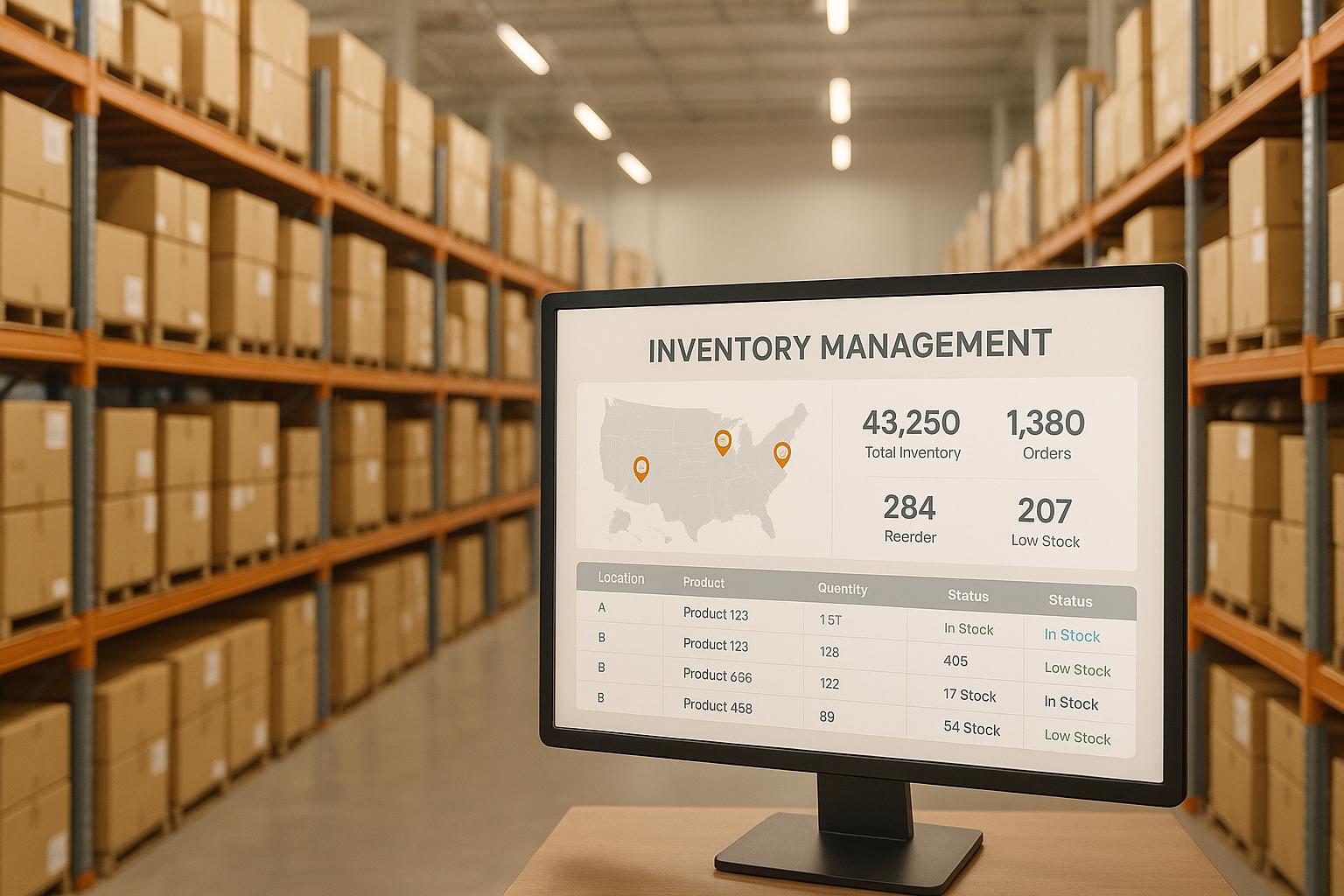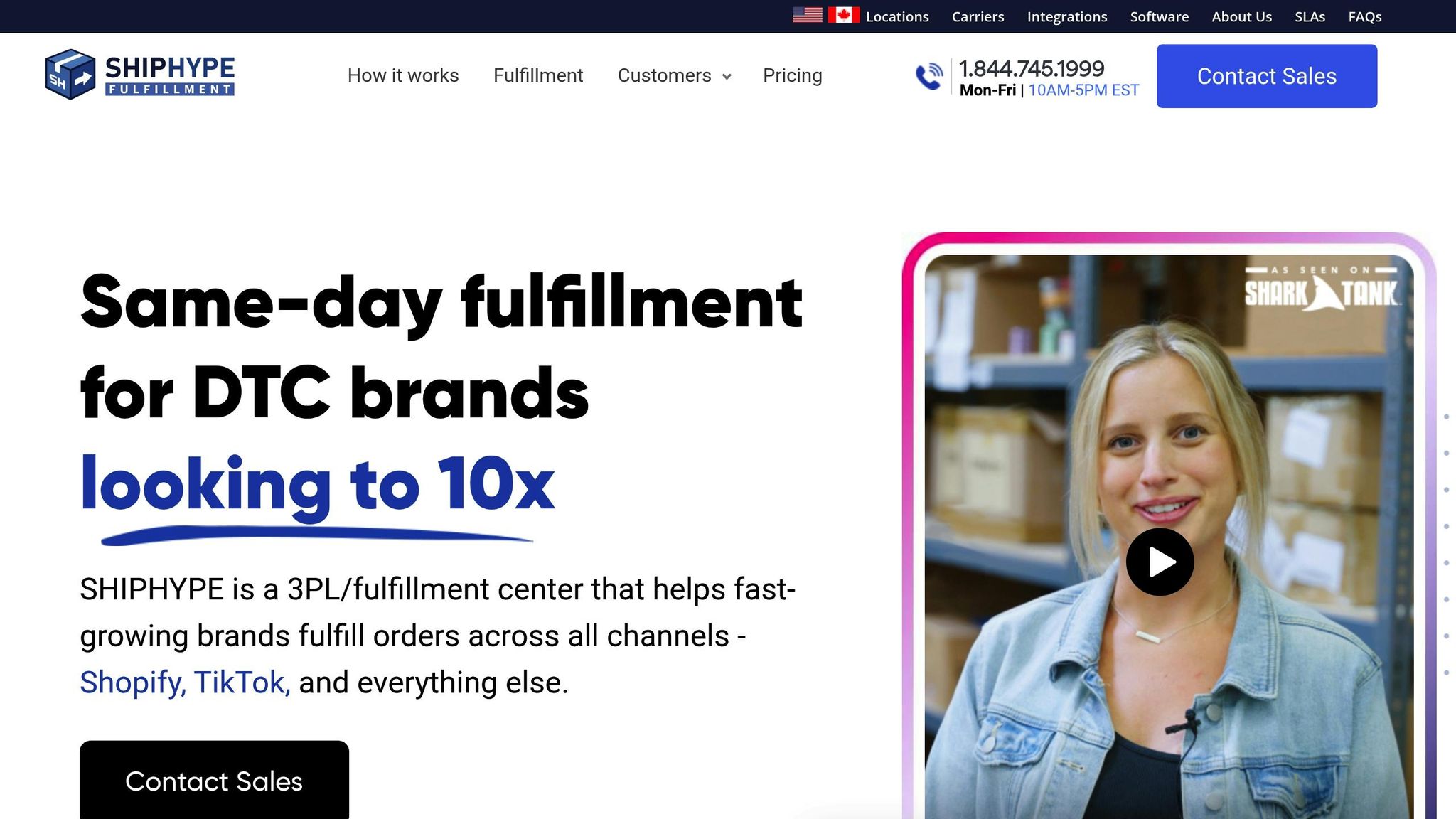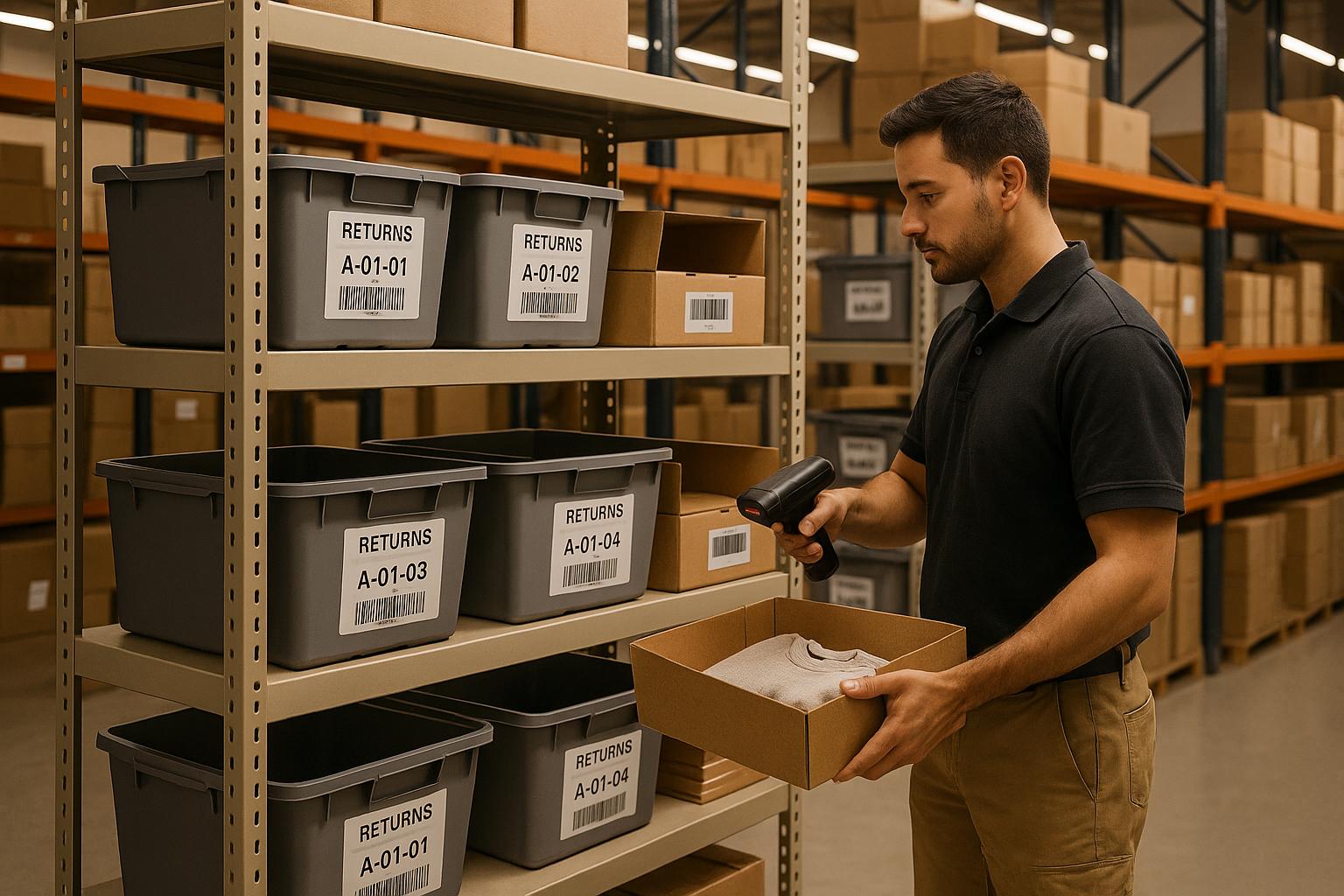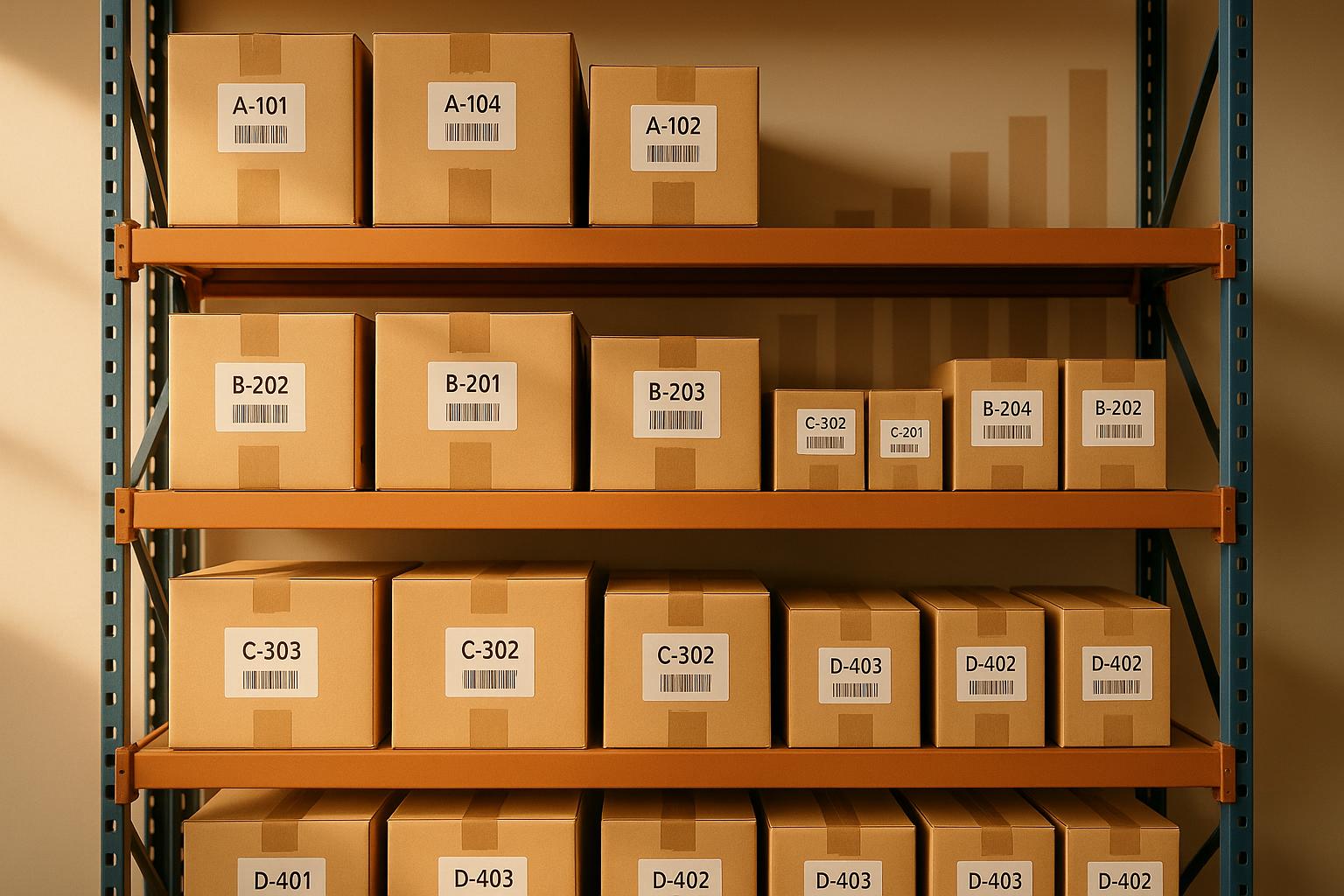How 3PLs Handle Multi-Warehouse Inventory

Managing inventory across multiple warehouses is critical for 3PLs to meet customer demands and ensure efficient delivery. Here's what you need to know:
- Faster delivery: By positioning inventory in regional warehouses, products reach customers quicker and reduce shipping costs.
- Risk reduction: Spreading inventory across locations minimizes disruptions from issues like natural disasters or labor shortages.
- Scalability: During peak seasons, multiple warehouses help balance order volumes, preventing bottlenecks.
- Challenges: Real-time tracking, inventory synchronization, and managing split shipments require advanced systems.
With tools like Warehouse Management Systems (WMS), real-time data, and predictive analytics, 3PLs ensure accurate stock levels, efficient order routing, and seamless coordination between facilities. These strategies improve service quality and help businesses scale without operational hiccups.
How 3PLs Save Money by Splitting Inventory Across Warehouses | SHIPHYPE

Technology and Tools for Multi-Warehouse Inventory Management
Managing inventory across multiple warehouses is no small feat. It demands advanced technology capable of handling intricate operations in real time. For 3PL providers, the key lies in using integrated systems that link all facilities, offering a unified view of inventory while keeping each location nimble. Here's how these tools drive precise inventory allocation and efficient order fulfillment.
Warehouse Management Systems (WMS)
A Warehouse Management System (WMS) is the cornerstone of multi-warehouse operations. Modern WMS platforms provide centralized dashboards that offer real-time updates on stock levels, order statuses, and performance metrics across all locations.
In a multi-warehouse setup, integration is non-negotiable. These systems must seamlessly connect with client e-commerce platforms, transportation management systems, and enterprise resource planning software. This ensures smooth automation of order allocation, selecting the best warehouse based on factors like inventory levels, shipping costs, and delivery timelines.
Scalability is another critical feature. As 3PL providers expand their networks or onboard new clients, the WMS must easily accommodate additional facilities without disrupting current operations. Cloud-based WMS solutions often shine here, offering the flexibility to scale operations quickly and cost-effectively.
Real-Time Data and Visibility
Real-time data synchronization is essential for maintaining accurate inventory records across multiple locations. When a product sells at one warehouse, the system updates inventory levels immediately across all facilities, reducing the risk of overselling.
Technologies like barcode scanning and RFID are vital for ensuring this real-time visibility. Every scan - whether during receiving, storage, picking, or shipping - feeds directly into the central database, keeping inventory data accurate at all times.
Dashboards take this data and turn it into actionable insights. Managers can monitor performance metrics like order accuracy, picking speeds, and inventory turnover across all warehouses. These insights help pinpoint inefficiencies, streamline workflows, and maintain high service standards.
Mobile technology further enhances real-time visibility. Warehouse workers equipped with handheld devices or tablets can instantly access inventory information, update stock counts, and receive task assignments, improving both productivity and data accuracy.
Automation and Order Routing
With accurate, real-time inventory data as a foundation, automation takes order routing and stock replenishment to the next level. Integrated systems work seamlessly to manage the complexities of coordinating multiple warehouses.
Smart algorithms direct orders to the best-suited warehouse, considering factors like inventory availability, distance, shipping costs, and delivery deadlines. If the nearest warehouse doesn’t have enough stock, the system can split the order across multiple locations or route it to the next optimal facility.
Automated inventory replenishment systems monitor stock levels across the network and trigger transfers when necessary. For instance, if one warehouse runs low on a high-demand item while another has a surplus, the system generates transfer orders to rebalance inventory and prevent stockouts.
Machine learning is now enhancing routing systems. By analyzing historical data - such as seasonal demand patterns, order volumes, and shipping performance - these systems continuously refine their decision-making to improve cost efficiency and service quality.
Integration with transportation management systems adds another layer of optimization. By factoring in real-time shipping rates and transit times from various carriers, routing algorithms ensure that decisions account for both cost and delivery speed, not just warehouse proximity.
At JIT Transportation, these advanced tools and systems are at the heart of our operations, enabling us to manage multi-warehouse inventory efficiently and effectively across our nationwide network.
Inventory Allocation and Distribution Methods
To ensure smooth operations, third-party logistics providers (3PLs) need to strategically position inventory across their networks. By using smart allocation strategies, they can cut shipping costs, speed up deliveries, and enhance overall service quality. The process relies on analyzing demand patterns, maintaining the right levels of safety stock, and leveraging data-driven forecasting. Let’s break down how 3PLs achieve efficient inventory distribution across multiple locations.
Demand-Based Inventory Allocation
Demand patterns play a major role in deciding where inventory should go. 3PLs study sales data, customer locations, and purchasing trends to distribute products across warehouses in the most effective way possible.
- Geographic demand analysis helps determine where products are needed most. Zone mapping, for instance, identifies customer clusters and order volumes to guide inventory placement.
- Velocity-based allocation categorizes products into fast, medium, and slow movers. Fast-moving items are spread across several warehouses to ensure quick access, while slower-moving items are centralized in fewer locations to avoid unnecessary stockpiling.
- Shipping zones and distances also factor into the equation. Products closer to customers can be shipped via standard ground services, ensuring cost-effective and timely delivery. For distant customers, alternative methods may be needed.
- Seasonal demand adds complexity. For example, summer items like pool supplies are stocked in warehouses serving areas where they’ll be in high demand during warmer months.
By aligning inventory with these factors, 3PLs can streamline operations and improve service efficiency.
Safety Stock and Inventory Balancing
Safety stock acts as a buffer to prevent stockouts, but finding the right balance is key - it must cover demand variability without tying up too much capital.
- Supplier lead times are a critical consideration. When delivery times fluctuate, warehouses need enough buffer stock to handle delays. 3PLs calculate safety stock based on both typical delivery schedules and potential disruptions.
- Demand volatility varies by product and region. Some items have steady demand with occasional spikes, while others are highly seasonal. Statistical models help determine the appropriate buffer levels for each scenario.
- Inventory balancing becomes essential when demand shifts between regions or supply disruptions occur. By actively monitoring inventory levels across the network, 3PLs can transfer surplus stock from one location to another to avoid shortages and maintain service levels.
- Service level agreements (SLAs) also influence safety stock decisions. Clients with stricter performance requirements may need higher buffer levels, and 3PLs work closely with them to adjust inventory while managing carrying costs.
This careful balancing ensures that inventory is always where it’s needed most, without unnecessary waste.
Predictive Analytics for Inventory Planning
Predictive analytics takes inventory planning to the next level by using historical data to anticipate future needs. By analyzing years of sales data, 3PLs can identify trends, seasonality, and growth patterns to make informed decisions.
- Machine learning algorithms enhance traditional forecasting by uncovering complex patterns that might otherwise go unnoticed. These systems consider variables like weather conditions, consumer sentiment, and more to refine demand predictions.
- Collaborative planning with clients further improves accuracy. When clients share details about promotions, new product launches, or marketing campaigns, 3PLs can adjust inventory placement to meet anticipated demand.
- External data integration adds another layer of precision. Economic indicators, weather forecasts, and industry trends can all inform inventory strategies. For instance, severe weather forecasts might prompt increased stock of essential items in affected regions.
Once safety stock levels are optimized, predictive analytics help fine-tune inventory for future demand. By regularly comparing actual demand with forecasts, 3PLs can identify gaps and continually improve their planning models.
At JIT Transportation, these strategies work hand-in-hand across our nationwide network. The result? Efficient inventory placement that strikes the perfect balance between service quality and cost savings for every client.
sbb-itb-eafa320
Order Fulfillment and Coordination Across Warehouses
Once inventory is strategically distributed across multiple warehouses, the next hurdle is ensuring efficient order fulfillment that meets customer expectations. For 3PL providers, success hinges on smooth coordination between facilities. Advanced systems play a crucial role by routing, consolidating, and dispatching orders quickly and accurately. These systems enable smarter order routing and seamless communication between warehouses.
Smart Order Routing
Smart order routing is essential for maximizing efficiency in a multi-warehouse setup. It automatically determines the best fulfillment location for each order, based on a variety of factors. These systems don’t just stick to fixed criteria - they adapt in real time, taking into account variables like workload at each facility and carrier performance. This flexibility ensures orders are fulfilled in a way that aligns with customer expectations.
Managing Split Shipments and Transfers
When an order requires items from multiple warehouses, things can get complicated. This is where 3PL providers step in to handle split shipments and inventory transfers with precision. Customers are kept informed with accurate tracking for each part of their order, ensuring transparency. To further streamline operations, providers may transfer inventory between warehouses to consolidate shipments. These transfers are often scheduled during off-peak times to reduce costs and prevent duplicate shipments, all while maintaining efficiency.
Backorder Management
Backorders happen when a customer orders an item that’s temporarily out of stock but will be delivered once inventory is replenished. Managing backorders effectively requires clear inventory visibility, proactive communication with customers, and well-coordinated replenishment efforts. When new stock arrives, advanced systems can reroute pending backorders to the warehouse that can fulfill them the fastest.
“Poorly managed backorders lead to missed delivery expectations, increased customer churn, negative brand reputation, and higher support costs”.
By synchronizing operations across all facilities, 3PL providers can avoid issues like duplicate shipments when inventory levels update. Prioritizing urgent orders and coordinating replenishments ensures backorders are resolved quickly, improving service quality. Using real-time data and predictive planning, providers can maintain delivery reliability.
At JIT Transportation, our nationwide network and advanced logistics systems make it possible to route orders efficiently and manage backorders proactively, ensuring customers receive their shipments on time - even in complex, multi-warehouse setups.
Data Synchronization and Workflow Management
Managing inventory across multiple warehouses isn’t just about having advanced systems - it’s about ensuring accurate data synchronization and efficient workflows. Without these, even the most sophisticated technology can’t prevent issues like overselling, mismatched stock levels, or delayed shipments. The real challenge is keeping information up-to-date and ensuring it flows smoothly between facilities, while all team members stick to consistent procedures. This seamless flow of data is the backbone of high-performing 3PL operations, laying the groundwork for accurate inventory reconciliation and smooth daily processes.
Real-Time Inventory Updates
Today’s 3PL providers rely on centralized inventory management systems to keep all warehouses in sync. For example, when a customer places an order and inventory is allocated at one location, that update is instantly reflected across the entire network. This prevents other warehouses from mistakenly reserving the same stock for different customers.
But it’s not just about tracking quantities. These systems also monitor details like lot numbers, expiration dates, and quality status. This level of precision is especially important for products that require special handling or need to meet regulatory standards.
By integrating these systems across facilities, 3PL providers eliminate manual data entry errors and reduce delays. The result? A steady flow of accurate information that keeps operations running smoothly.
Reconciliation and Cycle Counting
Over time, physical inventory can drift from what’s recorded in the system. Damaged goods, misplaced items, or human error are just some of the culprits. That’s where reconciliation processes and cycle counting come into play to ensure accuracy.
Cycle counts are scheduled based on factors like an item’s movement speed, value, and historical accuracy. For instance, fast-moving products might be counted weekly, while slower-moving items are checked monthly or quarterly.
To prioritize efforts, many 3PL providers use ABC analysis:
- Category A items: These are high-value products (often 20% of inventory but 80% of value) and are counted most frequently.
- Category C items: These are low-value, slow-moving products that require less frequent checks but still need monitoring.
When discrepancies arise, reconciliation starts immediately. This involves identifying the cause, correcting system records, and implementing fixes to prevent future issues. Advanced inventory systems can even detect patterns in discrepancies, helping uncover recurring problems like damaged goods or errors during receiving.
Perpetual inventory systems make this process even more efficient. These systems maintain a running count of inventory, allowing staff to verify accuracy during regular tasks like picking or receiving, rather than halting operations for full physical counts.
Standardized Operating Procedures
To maintain consistency across multiple warehouses, 3PL providers rely on standardized operating procedures (SOPs). These SOPs outline every step, from receiving and inspecting shipments to picking, packing, and shipping orders.
Documentation standards play a key role here. For example, when one warehouse labels an item as "damaged", that definition applies universally across all locations. This consistency eliminates confusion and ensures accurate data-sharing between facilities.
Uniform training ensures that staff can work efficiently across all warehouses. It also makes it easier to move employees between locations during busy seasons or unexpected demand surges. These standardized processes ensure that inventory data remains consistent and reliable, no matter where it’s handled.
Clear communication protocols are equally important. These define how and when information is shared between warehouses, including daily inventory updates, exception alerts, and escalation procedures for handling problems. With these protocols in place, no facility is left in the dark about critical issues that might affect the entire network.
Finally, quality control checkpoints are integrated into every process. These checkpoints include clear criteria for escalating problems to management, ensuring that issues are resolved quickly before they impact customer orders or inventory accuracy. Together, standardized procedures and integrated systems create a reliable foundation for maintaining data accuracy and operational consistency.
At JIT Transportation, we’ve built a robust system of standardized procedures and cutting-edge technology to ensure smooth data synchronization across our entire network. This allows us to maintain precise inventory control and efficient operations, no matter where your products are stored or shipped.
Key Takeaways on Multi-Warehouse Inventory Management
Managing inventory across multiple warehouses successfully relies on a combination of the right technology, strategic planning, and consistent operational practices. At the heart of this approach is a centralized inventory management system, which provides real-time visibility to minimize risks like overselling and stockouts.
Technology plays a huge role in streamlining operations. For instance, automated storage and retrieval systems can cut down space requirements by as much as 85%. Additionally, real-time data synchronization ensures all warehouses are updated instantly, enabling smooth coordination across locations.
Good inventory management isn’t just about logistics - it directly impacts customer satisfaction. Studies show that 24% of shoppers couldn’t buy what they wanted because items were out of stock. This highlights how poor inventory practices can hurt both sales and customer relationships. Strategies like smart order routing and demand-based allocation can significantly reduce these problems.
But technology alone isn’t enough. A solid inventory strategy is just as important. Effective operations go beyond basic stock distribution by using methods like ABC analysis to focus on high-value products, predictive analytics to forecast demand, and maintaining the right safety stock levels to avoid tying up too much capital. These practices help ensure popular products are closer to key customer hubs, while slower-moving items are consolidated for efficiency.
Consistent operational protocols are also vital for avoiding mistakes and delays that could lead to unhappy customers.
For businesses looking to streamline multi-warehouse inventory without building complex systems in-house, partnering with a seasoned 3PL provider like JIT Transportation can be a game-changer. JIT Transportation offers scalable solutions to handle inventory across multiple locations, allowing you to focus on growing your business. Whether you’re entering new markets or navigating seasonal demand shifts, their infrastructure adapts to meet your needs.
FAQs
How do 3PL providers manage inventory across multiple warehouses in real-time?
Third-party logistics (3PL) providers rely on warehouse management systems (WMS) and advanced tracking technologies like RFID and Bluetooth to keep inventory updates accurate and instantaneous across multiple warehouse locations. These tools automatically monitor stock movements and positions, minimizing manual errors and ensuring precision.
To keep everything in sync, 3PLs connect their systems with inventory management software, allowing smooth data sharing and constant updates. Key practices include conducting regular system audits, automating routine tasks, and using technology to maintain clear visibility of inventory across all sites. This approach ensures smooth and dependable supply chain operations.
How do 3PL providers use predictive analytics to improve inventory management across multiple warehouses?
Predictive analytics empowers third-party logistics (3PL) providers to improve inventory management by predicting demand, fine-tuning stock levels, and avoiding the pitfalls of overstocking or running out of stock. By digging into historical data and spotting market trends, 3PLs can make informed decisions that boost inventory accuracy and simplify warehouse processes.
This method enhances coordination across multiple warehouses, ensuring products are stored strategically to meet customer needs swiftly and efficiently. The result? A smoother, more dependable, and cost-efficient supply chain.
How do 3PL providers handle orders that require items from multiple warehouses to ensure on-time delivery?
When handling orders that involve multiple warehouses, 3PL providers rely on advanced warehouse management systems (WMS) and smart order routing. These tools evaluate key factors like stock availability, how close a warehouse is to the customer, and delivery timelines to determine the most efficient way to fulfill orders.
To keep things running smoothly, 3PLs synchronize inventory data across all their locations. This ensures stock levels are always accurate and coordination is seamless. They also refine their pick-and-pack processes to handle split shipments efficiently, minimizing delays. By combining technology with these streamlined practices, 3PLs make sure orders are delivered on time - even when items come from different warehouses.
Related Blog Posts
Related Articles

Top 3PL KPIs for Scaling E-commerce Brands

Best Practices for Returns Reconciliation in 3PL

